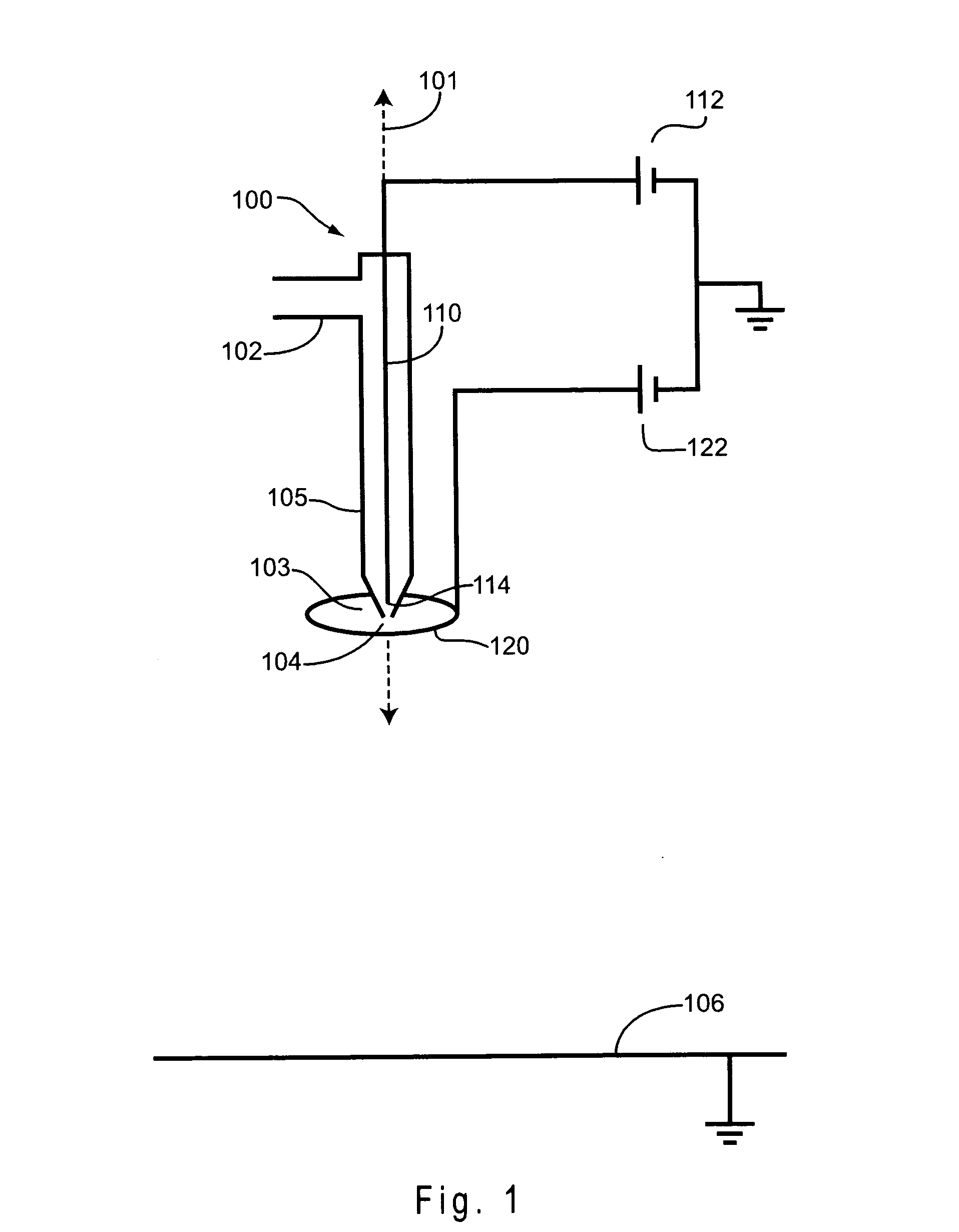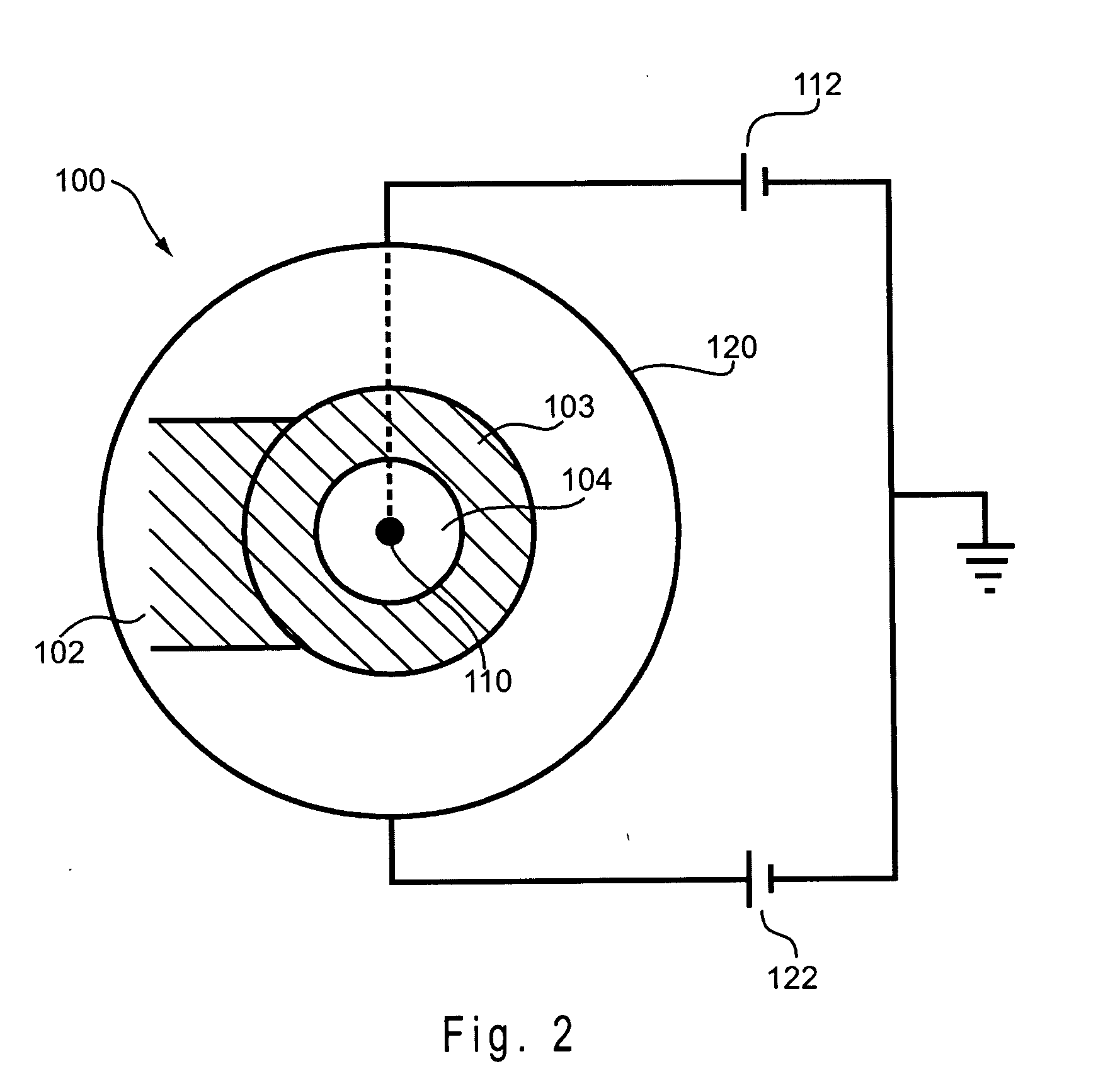Electrohydrodynamic spraying system
a spraying system and electrohydrodynamic technology, applied in the direction of liquid/solution decomposition chemical coating, superimposed coating process, light and heating apparatus, etc., can solve the problems of large film size, limited electrostatic force accumulation within liquid, and limited electrohydrodynamic spraying techniques, including clcb
- Summary
- Abstract
- Description
- Claims
- Application Information
AI Technical Summary
Problems solved by technology
Method used
Image
Examples
example 1
Two-Electrode Spray Apparatus
[0070] An electrohydrodynamic spraying system was constructed having a spray nozzle, an inner electrode, an outer electrode, and a substrate. The spray nozzle contained a liquid inlet and a tubular polypropylene portion. The substrate was positioned normal to the spray nozzle, and at a distance of 200 mm from the nozzle opening. Referring to FIG. 10, the inner diameter of the polypropylene tube 205 at its opening 206 downstream of the liquid inlet was 0.6 mm. At this downstream opening, a tubular, reducing glass insert 203 was stationed inside the polypropylene tube. The inner diameter of the reducing insert was 0.14 mm, and the length of the insert was 2 mm, with 1 mm of the insert in contact with the inner surface of the main tube. The downstream opening 204 of the reducing insert served as the opening for the nozzle 200. The inner electrode 210 was a tungsten needle, having a diameter of 125 microns and having a point 211 with a diameter of less than...
example 2
Variation of Voltage on Inner and Outer Electrodes
[0071] An electrohydrodynamic spraying system was used to spray a liquid mixture on a substrate. The liquid mixture contained a polymer mixture and a solvent mixture. The polymer mixture was a 1:20 blend of poly(3,4-ethylenedioxythiophene) and poly(styrenesulfonate), suspended in water at a 2.85 wt % solids content, available as BAYTRON P VP CH8000 (H.C. Starck; Newton, Mass.). The solvent mixture was 20:1 isopropyl alcohol and diethylene glycol, and the polymer was mixed with the solvent mixture for an overall composition of 1:20:1 of polymer mixture, isopropyl alcohol, and diethylene glycol. The liquid was passed through an electrohydrodynamic spray nozzle at a rate of 20 microliters per minute. The electrohydrodynamic spraying system was similar to that described in Example 1, except that the outer electrode was a ring having a diameter of 51 mm. The outer electrode was positioned 7.5 mm downstream of the nozzle opening. The subs...
example 3
Formation of Thin Film
[0073] An electrohydrodynamic spraying system was used to spray a liquid mixture on a substrate. The liquid mixture was identical to that used in Example 2. The liquid was passed through an electrohydrodynamic spray nozzle at a rate of 20 microliters per minute. The electrohydrodynamic spraying system was identical to that described in Example 1. The substrate was indium tin oxide (ITO) coated glass. A voltage of 20 kV was applied to the inner electrode, and a voltage of 12 kV was applied to the outer electrode.
[0074]FIG. 6 shows an SEM micrograph of a polymer film on the substrate, observed at an angle of 45 degrees. This film was deposited by spraying the liquid for 75 minutes. The outer electrode was positioned completely upstream of the nozzle opening, such that the distance between the downstream rim of the cup and the nozzle opening was 5.5 mm.
[0075]FIG. 7 shows an SEM micrograph of a polymer film on the substrate, observed at an angle of 45 degrees. T...
PUM
| Property | Measurement | Unit |
|---|---|---|
| distance | aaaaa | aaaaa |
| distance | aaaaa | aaaaa |
| distance | aaaaa | aaaaa |
Abstract
Description
Claims
Application Information
 Login to View More
Login to View More - R&D
- Intellectual Property
- Life Sciences
- Materials
- Tech Scout
- Unparalleled Data Quality
- Higher Quality Content
- 60% Fewer Hallucinations
Browse by: Latest US Patents, China's latest patents, Technical Efficacy Thesaurus, Application Domain, Technology Topic, Popular Technical Reports.
© 2025 PatSnap. All rights reserved.Legal|Privacy policy|Modern Slavery Act Transparency Statement|Sitemap|About US| Contact US: help@patsnap.com



